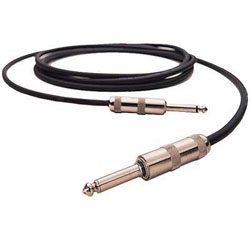
What is wire gauge? What gauge wire is used in instrument cables?
The diameter of copper wire is typically given in AWG (American Wire Gauge), with the larger numbers signifying smaller size.
For instance, a 20 AWG (or “20 gauge”) wire is smaller than an 18 AWG wire.
Generally, instrument cable center conductors are in the range of 18 to 24 AWG, with strands of 32 to 36 AWG.
Many American wire mills simply cannot work with wire smaller than 36 AWG because their equipment is too antiquated.
The Japanese manufacturers Canare and Mogami have been leaders in the use of very fine (40 AWG) copper stranding.
What gauge should the center conductor of an instrument cable be?
Since the current involved in instrument applications is negligible, the amount of copper in the center conductor has only a very slight effect on the strength of the signal reaching the amplifier.
In practice, the center conductor’s size is determined primarily by (1) the necessity of obtaining a maximum diameter of .265” or less while (2) providing sufficient tensile strength to withstand the rigors of performance without breaking.
The 20 AWG center conductor has become quite standard, normally in the form of 26 strands of 34 conductor has become quite standard, normally in the form of 26 strands of 34 AWG(26/34) or 41 strands of 36 AWG (41/36). A 20 AWG conductor has a breaking point of approximately 31 lbs.
Reducing conductor size to 22 AWG reduces breaking point to about 19 lbs. (a reduction of 39%); increasing it to 18 AWG increases the strength to over 49 lbs. (an increase of 58%). The most common cause of failure for instrument cables is broken center conductors.
What are the differences between tinned copper and bare copper stranded conductors?
Sometimes the individual strands of the center conductor are run through a bath of molten tin before assembling them into a wire.
Tinned copper wire is often easier to solder, especially if a lengthy (months to years) shelf life is required, because the tin coat prevents copper oxides from forming.
If the cable is to be used immediately upon manufacture pre-tinned strands are not required and add unnecessary expense.
Furthermore, an electrical phenomenon known as skin effect makes the use of tinned conductors a potential threat to the high-frequency signal-carrying properties of the cable.
However, the aging effects of the formation of copper oxides on untinned conductors may also cause a gradual deterioration of performance.
What is skin effect and how does it affect tinned copper?
Briefly, skin effect is caused by the magnetic field generated by the current flow in the cable causing electron flow to be concentrated more and more on the outer surface of the conductor as frequency increases.
If this outer surface is coated with tin, which has higher resistance than copper, the cable will have a falling highfrequency response and act as an attenuator.
What is oxygen-free and linear-crystal copper? How do they affect sound in cables?
There is a continuing debate concerning the use of oxygen-free and linear-crystal copper wire. These types of wire contain lower levels of oxide impurities and fewer crystal boundaries than standard copper.
Since these impurities form tiny semiconductors within the cable, the theory is that the cable itself introduces signal distortion, especially of low-level “detail” information.
These claims have been very difficult to document with scientific test equipment, but numerous listening tests suggest there is something to them.

